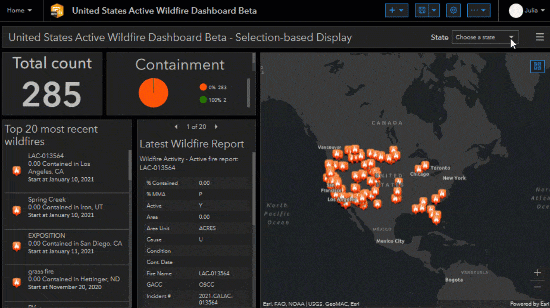Over the last year, more dashboards were created and shared publicly worldwide than ever before. Their uses ranged from public health, emergency management and disaster response, to public safety and public events. Dashboards change the way we explore relevant up-to-date information from a community or an authority and make data consumption easy and convenient. Publicly shared dashboards are just the tip of the iceberg. Many dashboards are created and shared within organizations beyond the public eye to help make decisions, visualize trends, and monitor status in real-time.
ArcGIS Dashboards technology has adapted to the increased usage and popularity with better performance, enhanced features, and refreshed designs. Rearchitected with the ArcGIS API for JavaScript 4.x, a new generation of ArcGIS Dashboards was launched in April 2020, available as a beta. Dashboards Beta takes advantage of the latest innovations in the ArcGIS platform so that both maps and dashboards are more performant. Support for Arcade expressions helps add additional context to the elements and draws attention of your audience to important values, events and situations. Additional metrics like percentile statistics were made available, along with new date filtering options and counts with non-empty and distinct values.
More than one thousand dashboards have been created each month with the beta. Thanks to the same user interface as the existing version of Dashboards, there is no learning curve to create or edit a dashboard with the beta version. Testing your existing dashboards with a beta version is as simple as opening it from the beta app here, or look for the Dashboards Beta logo in the ArcGIS Online App Launcher.
In the past few months, the team has been busy gathering feedback on the initial beta release and working to improve the beta product. Today, we are happy to announce that a new version of the ArcGIS Dashboards Beta is now available.
Here are some of the highlights included in this update.
Selection-based display
A new authoring option is available to set the display of dashboard elements to occur only when a selection is made. It allows authors to set conditions or dependencies for when and how data is displayed on a dashboard. A message or an image can be customized and shown on those elements to indicate that a selection is required.
Selection-based display can be applied in different scenarios to serve a variety of needs.
- Add more context to your dashboard and promote a more intuitive experience for your audience.
- Guide the audience to make a selection on your dashboard and get the information they are looking for. It’s particularly useful for someone who doesn’t have much GIS experience and relies on instruction outside of a dashboard to perform the work.
- If your dashboard is built to include a large dataset and requires a relatively long time to load, it’s a good option to consider in order to reduce that initial load time.
Overall, selection-based display helps create a more focused and context-sensitive dashboard, and helps your audience get the information they need more efficiently.
Learn more about using selection-based display in this blog.

Standalone tables are now supported as a data source
This is the support many beta testers have been waiting for. Now you can reference web maps that include a standalone table, or consume a layer with a related table. Any existing dashboards created that include standalone tables as data sources will now open as expected.
Take advantage of maps created in Map Viewer Beta
The exciting new capabilities of Map Viewer Beta are available when you bring those maps into the ArcGIS Dashboards Beta 2, such as group layers, dot density, clustering, pop-up improvements, and bookmarks.

[Updated in April 2021] For a complete list of enhancements available in the new ArcGIS Dashboards (now out of beta), refer to What’s New in ArcGIS Dashboards
We look forward to your feedback on the Esri Community Dashboards space (Esri Community Dashboards Beta space is now archived under general Dashboards space).

Article Discussion: